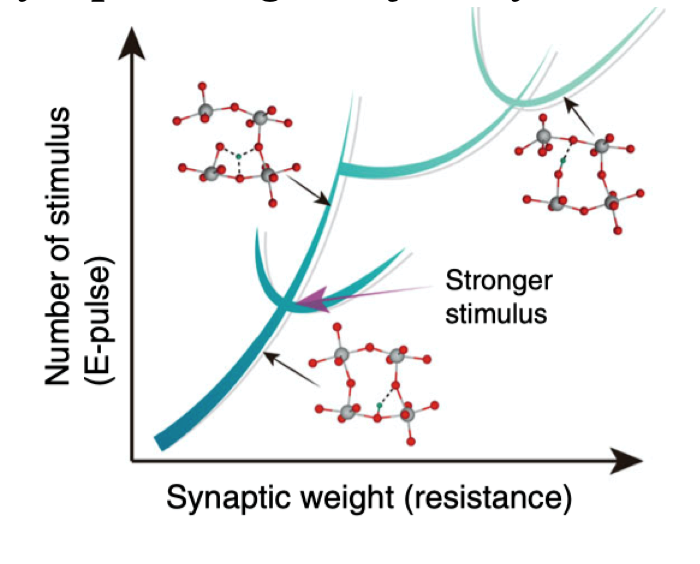In a new paper published in Nature Communications, physicists Alex Frano, Oleg Shpyrko and Ivan Zaluzhnyy of UC San Diego, along with collaborators from Purdue University, Argonne National Laboratory, University of Louisville, KY and Brookhaven National Laboratory, explain how the brain’s synapses encode memory by adapting their resistance, or “weight,” to electrical stimuli. While a synapse’s resistance increases or decreases with stimuli over the life of its host, it will not change to the point of breaking the neural circuit. This is because evolution developed a mechanism—a branch—to keep the circuit stable.
If the stimuli change in pulse, intensity or duration, however, the trajectory changes into another branch. After many such stimuli changes, the synaptic weight trajectory has many branches and thus many “learned” states—allowing the host a lifetime of learning—a tree of knowledge of sorts.
Similar to decision-tree algorithms in math, this tree-like structure for sustaining memory has been impossible to replicate in real materials. But in their paper, titled “Perovskite Neural Trees,” the national research team demonstrates the ability to generate tree-like trajectories of the electrical resistance of a material.
“We were so surprised to discover how the resistance trajectory of our devices mimics those of actual brain synapses,” said Frano. “The ability to make ‘neural trees’ or ‘decision trees’ in hardware is very exciting.”
The scientists explain in their paper that the difficulty has been finding real materials that can host multiple states that can each be uniquely identified electrically and are capable of learning. They overcame these challenges, however, by discovering a material that displays these properties.
“We show they can operate safely without catastrophic breakdown, and we demonstrate that they can learn. The results open up a new dimension of safe hardware for AI and neuromorphic computing,” Frano said.
In their study, the researchers exercised atomic-scale control over proton migration in a nickel-oxide thin film subject to nanosecond electric pulses (see Figure 2). The resistance of these materials is highly sensitive to proton doping (i.e., one proton addition per chemical formula leads to ~10 orders of magnitude change in electrical resistance) and electric field pulses (the resistance changes upon applying electric field pulses). The latter occurs through the migration of protons relative to the electric field.
The team at UC San Diego applied a novel experimental technique of focusing an X-ray beam down to 20 nanometers, so they could “visualize” how the protons move around the sample as they create new tree branches. According to the researchers, the quantum mechanical amplification effect from proton drift enables a vast number of tree memory states that are dynamically programmable using electrical pulses. Together, these aspects form the basis of neuromorphic hardware synapses.
“Our team was excited to literally ‘see’ how the migration of protons inside the material gives it the chance to develop a resistive trajectory, or ‘branch,’” said Frano. “Furthermore, different pulses reorganize the protons in different configuration, yielding another branch. The sheer ability to detect the migration of light hydrogen protons at the nanometer scale was incredibly exciting to us.”
The impact of these findings spans a range of fields.
“On the one hand, these can be now implemented into architectures of neuromorphic hardware. For instance, software/hardware hybrid systems can now be designed. On the other hand, now that we understand better the physical mechanism by which we can create these artificial neural trees, we can explore other materials that can allow us to do that,” Frano said. “Finally, the technique we developed to visualize the motion of protons, we can use it to understand other relevant phenomena like electromigration and phase separation in materials.”
This study was supported by the Gilbreth Fellowship, College of Engineering at Purdue University; AFOSR (FA9550-19-1-0351); ARO W911NF1920237; the “Quantum Materials for Energy Efficient Neuromorphic Computing,” an Energy Frontier Research Center funded by the U.S. Department of Energy (DOE), Office of Science, Basic Energy Sciences (award no. DE-SC0019273, DESC0001805 and contract no. DE-AC02-06CH11357); the U.S. DOE Office of Science operated by Brookhaven National Laboratory (contract no. DE-SC0012704) and the National Energy Research Scientific Computing Center (NERSC), a U.S. Department of Energy Office of Science User Facility (contract no. DE-AC02-05CH11231).
Original post https://alertarticles.info


